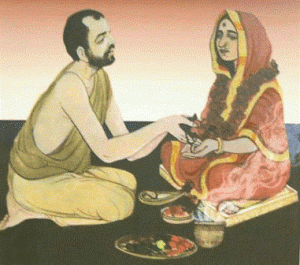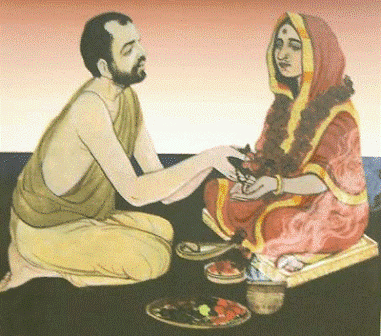The Phalaharini-Kali-Puja is performed in many centres of the Ramakrishna Math and Mission. This Kali Puja has a special bearing on the Ramakrishna Sangha. On this day Bhagavan Sri Ramakrishna observed the end of his sadhaka-life in a special way. He worshipped Sri Saradamani Devi as Goddess Shodasi on this day. All of us know that Adyashakti (the Primordial Energy) has various names and forms. Of those, Kali, Tara, Shodasi, Bhuvaneswari, Chhinnamasta, Bhairavi, Dhumavati, Bagala, Matangi and Kamala—these ten forms are well-known. Sri Ramakrishna worshipped the Adyashakti, the Goddess of the universe through the manifestation of the `Vidya-rupini’, a female human form embodying the transcendent knowledge, and surrendered himself, his rosary and all other aids to his sadhana at Her feet and thus drew an end to his long, historic, and all-encompassing sadhana.

Shodashi Puja
Why did Sri Ramakrishna worship Holy Mother as the Goddess Shodasi? The Ramakrishna Sangha belongs to the dasanami sampradaya of Shankaracharya. This Dasanami Sampradaya includes the ten monastic systems, holding the name of Puri, Girl, Bharati, Tirtha, Ban, Aranya, Parvat Ashrama, Sagar and Sarasvati. The monastic organization of ours belongs to the Puri Sampradaya. Srimat Tota Puri was the Sannyasa Guru of Sri Ramakrishna. That’s why we also belong to the Puri Sampradaya of Sannyasins. The original Math of this Puri Sampradaya sannyasins is the Sringeri Math. Every sampradaya has various gods and goddesses. The presiding deity of the Puri Sampradaya is Kamakshi Devi. The temple of Kamakshi Devi is at Kanchipuram in South India. In that temple there is the Shodasi murti of the Devi. The other names of Shodasi Devi are—Rajarajeswari, Tripurasundari or Sri Vidya.
In South India the worship of Sri Vidya is especially in vogue. The worship that is prevalent in Bengal is called the Kalikula Upasana ; and the worship that is in vogue in the South India is called Sri Kula Upasana. Acharya Shankara founded four Maths at the four corners of India, for the sannyasins. In the Sringeri Math in South India he placed Sri Yantra as the presiding deity, and arranged for its daily worship. In Kanchipuram he consecrated the temple to the Devi and named Her Kamakshi; he installed Sri Yantra there too. This goddess Kamakshi is the Ishta-devi, the chosen deity of the Puri Sampradaya monks. Every God has a specific Yantra. These Yantras, made by certain specific curves and lines, are thought of as the seat of particular gods. In Sringeri Math Sri Yantra was installed as the presiding deity of the Sannyasins there. Devi Shodasi, also called Kamakshi, Tripurasundari, or Sri Vidya, as has been told earlier, is the presiding deity of the Puri Sampradaya. Bhagavan Sri Ramakrishna, after being ordained into sannyasa, came under the fold of Sri Kula of the Puri Sampradaya. Though he started his sadhana in the Kali-Kula, he ended it after embracing Sri Kula and following its instructions. This fits squarely with the injunctions of the Tantra scriptures. In South India Tantra sadhana is attested by, and follows Parashurama-kalpa sutra. In that Parashurama Sutra the chief deity of the Sri Kula has been called Samrajni. Saiyam Samrajni. Sri Devi is the Samrajni—the queen amongst all the goddesses. Shyama or Kali is Her chief attendant. So, for worshipping Sri Vidya, Shyama is to be worshipped first. Why? Why is the chief attendant’s worship first? Samrajni, the empress, should have been worshipped first. But no. To adore the King, the minister is to be pleased first. Pradhanadvara rajaprasadanam hi kuryat. That is why a sadhaka after attaining the siddhi, fulfilment in Kali worship, also gains access to the worship of Sri Vidya or Samrajni Shodasi Devi.
Of course, Sri Ramakrishna did not consult scriptures nor did he do such sadhana after knowing fully well of its purport. His life itself comprises scriptures. As we have seen, after the realization of the Divine Mother of the universe, Kali, it is Divine Mother who led him, one after another, through various forms of sadhana. Through his life the truths of the scriptures and objectives of various sadhanas, were re-verified and revivified. One after another these sadhanas came in his life spontaneously and in natural course. And all those sadhanas happened to run in the same lines prescribed by the scriptures. He attained siddhi in the sadhana of Kali-Kula. He attained the vision of Mother Kali and then performed the Upasana of Sri Vidya. But he did not perform the worship of Sri Vidya in any clay image. Sri Vidya found Her incarnation in the body and mind of one divine woman. That divine woman is Devi Saradamani. She is identical with Sri Vidya. Sannyasin Sri Ramakrishna worshipped this Samrajni as the highest manifestation of the Primordial Energy. He worshipped Kanchipuram’s presiding deity Devi Shodasi, Kamakshj as Tripurasundari, through this Devi Saradamani.
From that very day it was ordained that Devi Sri Vidya of our monastic organization would conduct and guide Sri Ramakrishna Sangha through Her human form of Sarada Devi. This is the philosophy behind Phalaharini Kali Puja in our Ashramas. The devotees of Sri Ramakrishna perform Phalaharini Kali Puja, recalling Sri Sri Ma. The philosophy depicted above has given Phalaharini Kali Puja a special bearing on the Ramakrishna Order. ❑
– by Swami Hiranmayanandaji, the then General Secretary, Ramakrishna Math and Ramakrishna Mission, Belur Math.
(Published in Prabuddha Bharata, Dec 1992)
